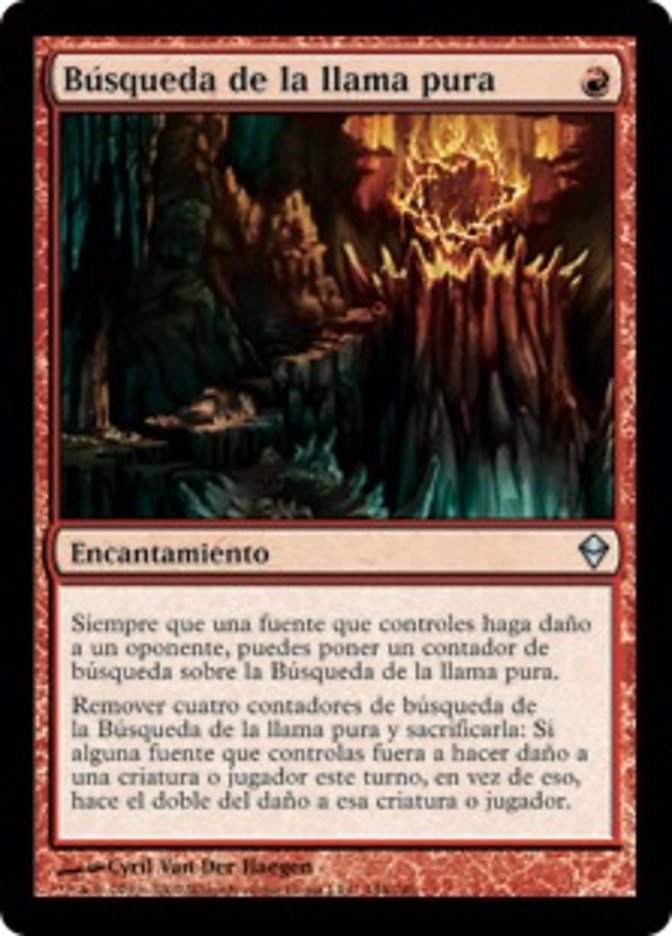
Búsqueda de la llama pura {R}
Encantamiento
Siempre que una fuente que controles haga daño a un oponente, puedes poner un contador de búsqueda sobre la Búsqueda de la llama pura.
Remover cuatro contadores de búsqueda de la Búsqueda de la llama pura y sacrificarla: Si alguna fuente que controlas fuera a hacer daño a una criatura o jugador este turno, en vez de eso, hace el doble del daño a esa criatura o jugador.
Illustrated by Cyril Van Der Haegen
- Standard
- Not Legal
- Alchemy
- Not Legal
- Pioneer
- Not Legal
- Explorer
- Not Legal
- Modern
- Legal
- Historic
- Not Legal
- Legacy
- Legal
- Brawl
- Not Legal
- Vintage
- Legal
- Timeless
- Not Legal
- Commander
- Legal
- Pauper
- Not Legal
- Oathbreaker
- Legal
- Penny
- Legal
Toolbox
Buy This Card
Notes and Rules Information for Búsqueda de la llama pura:
- Only the English version of a Magic card receives Oracle updates and errata. View this card in English. (Scryfall note)
- The second ability affects all sources you control that would deal damage to a permanent or player at any point in the rest of the turn. (2009-10-01)
- Both of Quest for Pure Flame’s abilities interact with any kind of damage, not just combat damage. (2009-10-01)
- The source of combat damage is the creature that dealt it. (2009-10-01)
- If a spell causes damage to be dealt, that spell will always identify the source of the damage. In most cases, the source is the spell itself. For example, Lightning Bolt says “Lightning Bolt deals 3 damage to any target.” (2009-10-01)
- If an ability causes damage to be dealt, that ability will always identify the source of the damage. The ability itself is never the source. However, the source of the ability is often the source of the damage. For example, Prodigal Pyromancer’s ability says “Prodigal Pyromancer deals 1 damage to any target.” (2009-10-01)
- If the source of the damage is a permanent, Quest for Pure Flame checks whether you control that permanent at the time that damage is dealt. If the permanent has left the battlefield by then, its last known information is used. If the source of the damage is a spell, whether you control it is obvious. If the source of the damage is a card in some other zone (such as a cycled Jund Sojourners), Quest for Pure Flame checks whether you’re the card’s owner, rather than whether you’re its controller. (2009-10-01)
- When the first ability resolves, you may put just one quest counter on Quest for Pure Flame. It doesn’t matter how much damage the source dealt. (2009-10-01)
- The first ability will trigger multiple times if multiple sources you control deal damage to a single opponent at once, or if a single source you control deals damage to multiple opponents at once. (2009-10-01)
- If multiple effects modify how damage will be dealt, the player who would be dealt damage or the controller of the creature that would be dealt damage chooses the order to apply the effects. For example, Mending Hands says, “Prevent the next 4 damage that would be dealt to any target.” Suppose a spell controlled by a player who has activated Quest for Pure Fire’s second ability would deal 5 damage to a player who has cast Mending Hands targeting themselves. The player who would be dealt damage can either (a) prevent 4 damage first and then let Quest for Pure Fire’s effect double the remaining 1 damage, taking 2 damage, or (b) double the damage to 10 and then prevent 4 damage, taking 6 damage. (2009-10-01)
- If a spell or ability divides damage among multiple recipients (such as Arrow Volley Trap does), the damage is divided before Quest for Pure Fire’s effect doubles it. The same is true for combat damage. (2009-10-01)
- If you activate the second ability of more than one Quest for Pure Flame in the same turn, the effects are cumulative. Two such effects will cause damage from sources you control to be multiplied by four; three such effects will cause damage from sources you control to be multiplied by eight. (2009-10-01)